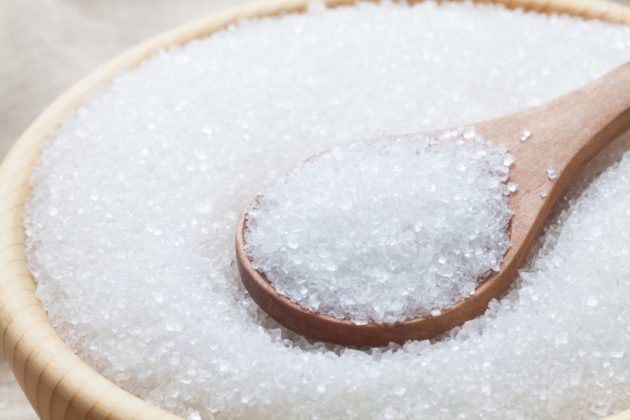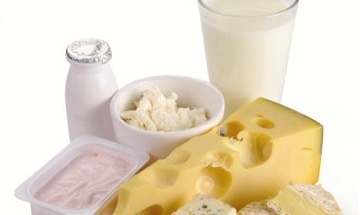
Techniques for reducing sugar content in dairy products show promise
By Food in Canada staff
Research & Development Dairy dairy products White sugar with spoon in wooden bowl, Close-up.
White sugar with spoon in wooden bowl, Close-up.  PHILADELPHIA—Dairy foods are popular among consumers, and sales gross more than $125 billion per year according to the International Dairy Foods Association. With dairy product popularity comes new demands from consumers for healthier, low-calorie products that taste the same as their higher calorie counterparts. In a report published in the Journal of Dairy Science researchers review the options available to the dairy industry to reduce sugar in products such as ice cream, yogurt, and flavoured milk without sacrificing flavour.
PHILADELPHIA—Dairy foods are popular among consumers, and sales gross more than $125 billion per year according to the International Dairy Foods Association. With dairy product popularity comes new demands from consumers for healthier, low-calorie products that taste the same as their higher calorie counterparts. In a report published in the Journal of Dairy Science researchers review the options available to the dairy industry to reduce sugar in products such as ice cream, yogurt, and flavoured milk without sacrificing flavour.
Overconsumption of sugar can contribute to a host of issues such as hypertension, type 2 diabetes, cardiovascular disease, and dental cavities.
“Dairy foods represent a large market,” lead investigator MaryAnne Drake, PhD, William Neal Reynolds Distinguished Professor, Department of Food, Bioprocessing, and Nutrition Sciences, Southeast Dairy Foods Research Center, North Carolina State University, said in a release. “The dilemma of how to reduce sugar content without sacrificing flavour and negatively affecting product sales is challenging, as sugar plays an important role in dairy foods, not only in flavour, but also in texture, colour, and viscosity. Replacing sugar can have negative effects, making substitution inherently difficult.”
Dairy products like ice cream, yogurt, and flavoured milk are potentially high in unwanted added sugar. Some of the standard processes for developing healthier food products, such as fat, sugar, and salt reduction, result in an unacceptable flavour. Sweet taste perception can also be affected by texture of the food matrix and the presence of fat. Other sugar reduction techniques include hydrolysis of lactose, ultrafiltration, and direct reduction. In this review, researchers reviewed recent studies to assess the role of sugar, alternative sweeteners, and sugar reduction in ice cream, yogurt, and flavoured milk and discuss the options available to the dairy industry.
To achieve the sweet taste in ice cream desired by consumers, between 10 to 14 per cent sugar needs to be added. Studies have shown that reduced sugar and reduced fat products show a higher propensity for a bitter aftertaste and a lower intensity of creaminess. Among the promising options the researchers found were:
Calorie-reduced ice creams sweetened with sorbitol and sucralose were most accepted compared with other “light” vanilla ice creams or ice cream with a minimum reduction of 25 per cent of the total energy, sugar, or lipid.
Chocolate-flavoured ice creams are typically formulated with higher sugar content to decrease the bitterness associated with cocoa. When the sugar is reduced, not only does the ice cream taste more bitter, but it also tastes less chocolatey. In one study, researchers proposed a solution by marketing sugar-reduced chocolate ice cream to dark chocolate lovers, who already desire and tolerate substantially higher levels of bitterness.
Frozen yogurt is often viewed as a healthy alternative to ice cream because of its lower fat content and the presence of lactic acid bacteria, even when frozen, but the sugar content is typically the same as regular ice cream. A study of frozen yogurt determined that substituting inulin and isomalt for sugar and fat led to a similar sweetness and a reduction in fat with no added sugar.
Although yogurt is generally recognized as a healthy food, it is usually sweetened with sugar to increase palatability. Several studies have reported that liking yogurt is influenced by texture, aroma, and taste and that sweetness is an important component.
Several studies found that sweetener blends of non-nutritive sweeteners have been very successful in reducing sugar content of yogurt.
One study reported that it was possible to produce a probiotic yogurt successfully using sweeteners without affecting the viability of the probiotic microorganisms. The addition of non-nutritive sweeteners did not negatively affect the yogurt-making process because the sweeteners did not break down over time.
Flavoured milk is popular among children and adults because of its special taste and ability to meet the dietary requirements for dairy foods in the U.S., as studies have shown that flavoured milk increases milk consumption. Chocolate milk typically has higher sugar content and is a frequent target for sugar reduction techniques.
However, reducing sugar in chocolate milk is quite costly and many school directors choose the higher sugar alternative to reduce cost or choose to eliminate chocolate milk entirely. There have been several studies into alternative ways of reducing sugar calories in chocolate milk with some contradictory results.
One study showed that withdrawing a chocolate milk option meant that three or four additional foods needed to be added into the diet to replace the nutrients from milk, adding additional calories and cost. Therefore, sugar-reduced chocolate milk should be considered the cheaper alternative.
In another study parents preferred natural non-nutritive sweeteners over nutritive sweeteners as the sweetener source in chocolate milk.
Some studies found that added sugar could be directly reduced in chocolate milk and still be accepted by children and adults if it did not exceed 30 per cent.
Overall, the most successful techniques for sugar reduction in dairy foods involve replacing sugar with non-nutritive sweeteners, whether natural or artificial, because these provide the sweet taste desired by consumers without added calories. Direct reduction of sugar and lactose hydrolysis methods also show promise.
“Understanding current sugar-reduction techniques, research, and consumer response to sugar reduction in dairy products is important for dairy manufacturers in order to design and produce sugar-reduced products,” notes Dr. Drake. “Sugar reduction is an inherently difficult task due to the many functions of sugar in food products, but progress is being made in developing products acceptable to consumers.”
Print this page